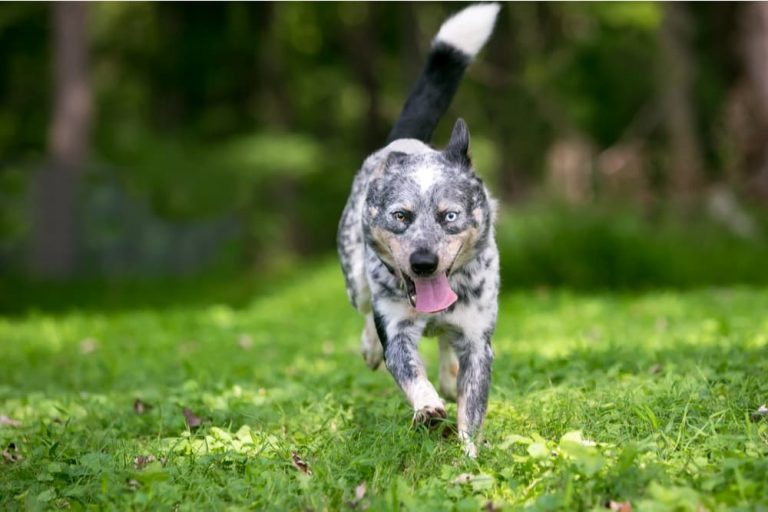Dog Zoomies: Understanding Why Dogs Run Like Crazy

You’ve probably seen your dog suddenly make a wild dash through the house, perhaps after a bath or a walk, and thought, “what the heck is he doing?!”
This behavior is known as dog “zoomies,” according to Gary Weitzman, president and CEO of San Diego Humane Society. “Zoomies are how [dogs] release pent-up energy,” he says. “Dogs never appear happier than when they are doing zoomies!”
What Are Dog Zoomies?

Although we call these short bursts of energy “zoomies,” the official term is frenetic random activity periods or FRAPs. These sudden bouts of energy are different than traditional canine playtime, too. Dogs experiencing zoomies tend to dart back and forth quickly and may try to get you or another animal to join the fun.
“Zoomies are more frantic and repetitive in nature than regular play,” Weitzman says. “They can come on when your dog is happy and excited, or they can also be a way for dogs to release nervous energy, like after a bath or going to the vet.”
Although the dog zoomies can happen at any time, they are prevalent after walks, bath time or grooming, Weitzman says.
Why Do Dogs Get the Zoomies?

Zoomies are typical when dogs have an abundance of physical or mental energy to burn, according to Jill A. Goldman, certified applied animal behaviorist and founder of DJG Animal Behavior Services. And dogs of all ages and breeds can get the zoomies.
“All dogs can have these kinds of behavior patterns,” Goldman says. “Whether all dogs need to display these behavior patterns may vary.”
Goldman says that the behavior can be more common in younger dogs and high-energy breeds (that’s why your senior Chihuahua may experience zoomies less often than a 1-year-old Border Collie). But even older dogs can zoom if they need to release energy, Weitzman says.
Your reaction to the behavior may also play a role in their frequency. “It’s naturally reinforced because it feels good, but if we think it’s funny and give a little bit of enthusiastic reinforcement (whether it’s intentional or not), it can also influence how often the dog displays the zoomies,” Goldman says.
Why Do Dogs Get the Zoomies After a Bath?

Does your dog race around the house at top speed as soon as he gets out of the tub? It’s not the scent of shampoo getting him excited.
“Most dogs don’t love bath time, so zoomies after a bath usually mean your dog is releasing some nervous energy,” says Weitzman. “They could also be trying to dry off.”
Zoomies can also be seen after a grooming appointment. The stress of standing on a grooming table and being handled by a stranger are key reasons dogs may leave the groomer with a lot of nervous energy to burn, Goldman says.
Why Do Dogs Get the Zoomies After a Walk?

It’s also normal for your dog to have a furious burst of energy after a walk.
“Dogs have an exceptional sense of smell and they take in a tremendous amount of stimuli when they sniff around,” says Weitzman. “Even though they burn a lot of energy on the walk, they have so much excitement from everything they just saw and smelled zoomies are how they release it.”
If your dog routinely gets the zoomies after a walk, you may not be giving him enough exercise.
“If you’ve ever been to an aerobics class, the first 15 minutes are a warm-up,” Goldman says. So if you’re giving your dog a 15 or 20-minute walk, it’s essentially a warm up that can trigger zoomies when they come back inside.
Are Dog Zoomies Normal?

In a word, yes. Weitzman notes that zoomies are not a behavior pet parents should be worried about. “Zoomies are a very normal part of dog behavior,” he says.
Keeping Dogs Safe During Zoomies

The zoomies can come on suddenly, which means your dog is just as likely to race around the living room as the backyard. The quick movements, fast pace, and intermittent jumping can cause injuries from slipping on hardwood floors or crashing into the hard edge of the fireplace.
To encourage zoomies and keep your dog safe, Weitzman suggests opening a door to a yard or creating more open space for them to run during their behavior.
Indoors or outdoors, it’s also important to remove your dog’s leash (as long as your dog is in a safe area). Goldman warns that a leash could get caught on something during an episode of the zoomies, causing injuries.
How to Stop Dog Zoomies

Since zoomies are a normal dog behavior, there’s no need to stop your dog from their solo play sessions unless it’s inconvenient or unsafe.
If you’re in a small apartment where there isn’t enough space for your dog to race around without injuring themselves or others—or if their zoom sessions annoy the downstairs neighbors—you may need to put the brakes on.
“If you don’t have a yard, leash your dog and take him for a walk or a run,” Weitzman says. “Any activity that will help your dog release the energy he’s feeling will help him to relax.”
Otherwise, just sit back and enjoy the show. “It’s a healthy expression for the dog and one of the most entertaining things to watch,” he adds. “Enjoy it.”









